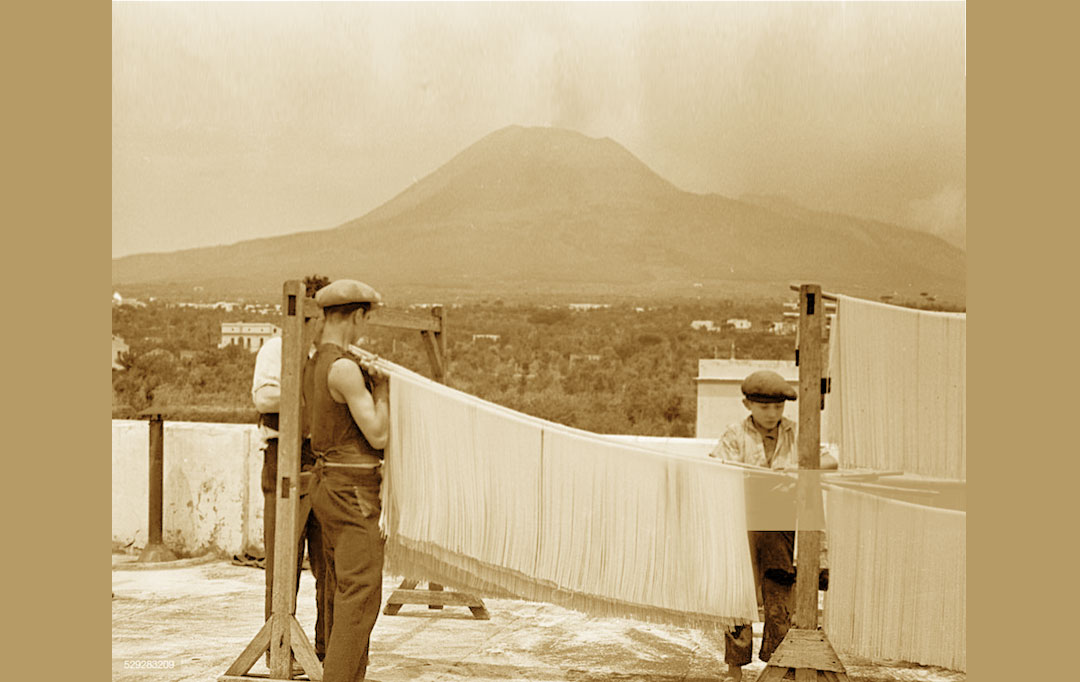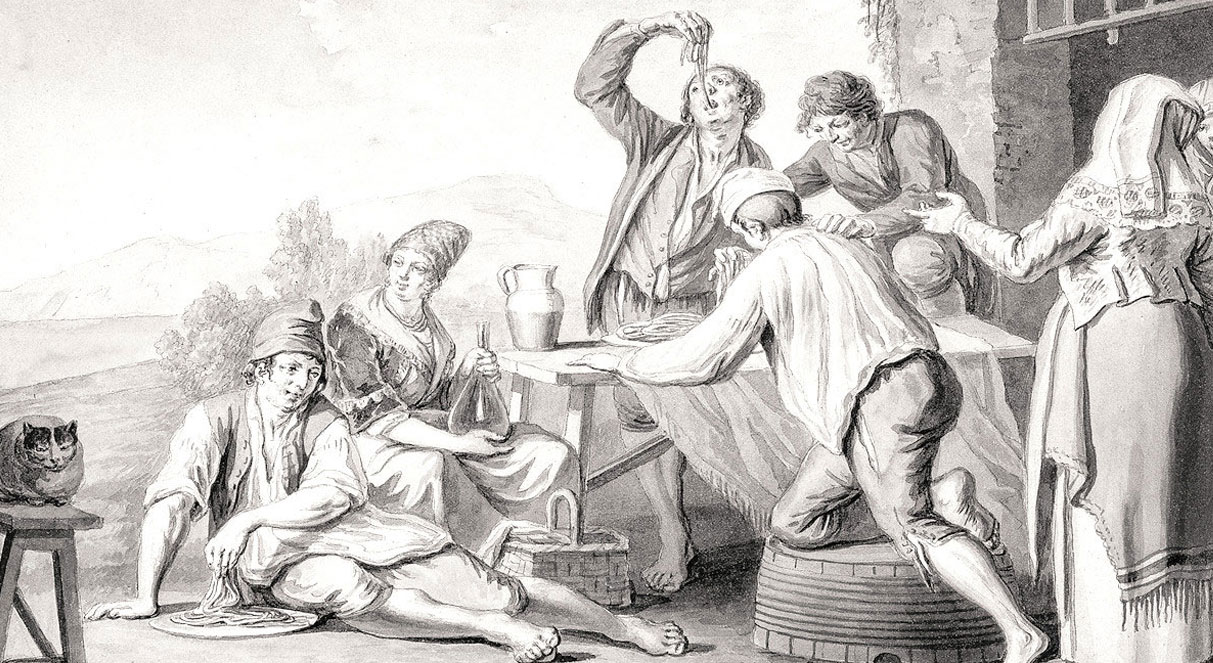
All about pasta
All about pasta
Even today there’s no real answer to who originally came up with pasta. Chinese, Arabs and Italians are first to come to mind among the possible candidates. According to one of the theories, the Chinese knew pasta receipt back in 5000 B.C. Arabs started cooking pasta in 5th century B.C. There is a documented proof of ancient Romans cooking dough with water and baking flour, by frying it, cutting into strips and serving with a sauce.
It’s a fact that in 1292 Marco Polo brought from China to Italy something similar to tagliatelle. However, historians imply that pasta was already widely spread and known in Italy before that. One of the Etruscan tombs depicts tools for making pasta: A bakeboard, a rolling pin, a wheel for cutting pasta are the tools that are used to prepare pasta even today.

In Sicilia in the 12th century people ate long and thin pasta, reminiscent of modern spaghetti. Meanwhile in Calabria people learned to roll the pasta into tubes. A cooking book of the 13th century that traveled the world before Marco Polo returned from China, describes a few types of pasta including ravioli, vermicelli and tortellini. Pasta presence in Italy before Marco Polo is proven by documents, pictures and engravings in the Pasta Museum in Rome.
During the Renaissance, rich Florentines ate pasta with sugar and expensive spices, the poor however often ate pasta with garlic, cheese, vegetables or without any spices. Back in those days, the pasta was always homemade and fresh. Dry pasta was first practiced in Naples. Apparently, there are perfect conditions nearby the city to grow durum wheat which is used for pasta flour, while the unique combination of wind and sun was great for drying the pasta. Soon Naples was surrounded by factories and pasta production took on the industrial route. First sorts of pasta produced in factories were penne and spaghetti. At the end of the 18th century first pasta factory in Odesa was opened.
A brief timeline of pasta production development
- 12th century – pasta production in Sicily with local slave labor.
- 13th century – dry pasta production, making it possible to store it for a few years and use as food on ships. Pasta is shipped to Venice, Genoa, Pisa, Naples and other sea cities-states. New types of pasta appear in each of the cities.
- 15th century – first mention of long and piena pasta. Since durum wheat was grown only in Sicily and Apulia back then, pasta was far from poor’s man provision and was not so popular among the poor population.
- 16th – 17th centuries — whole Southern Italy starts growing durum wheat. Tomatoes are shipped to Europe from America. It was a true gastronomic revolution. Invented and widely used mechanical machines for making pasta: presses, cutting machines and drying machines. Pasta is cheaper and more affordable now.
- During 18th – 19th centuries pasta gains the popularity it has even till this day. Also, pasta is massively spread in Europe and America, becoming one of the most popular dishes.
RATING POPULARITY OF PASTE

Types of pasta
Today the market offers more than 600 types of different pasta forms. Moreover, their wonderful diversity may vary from classical rolls to tennis racquets. Almost any significant event in the world may inspire manufacturers to create pasta of a new shape.
In shapes and sizes pasta can be categorized in:
- Long pasta (spaghetti, butkati, linguine, mafalda (manfredi))
- Short pasta (macaroni, fusilli, penne)
- Small pasta (ditalini, campanel)
- Figurative pasta (gemelli, radiatori, farfalle, sicilian flower)
- Pasta with filling (canneloni, ravioli)
Types of cooking pasta can be categorized into 3 groups:
- Dry pasta – pasta made from durum flour and water
- Fresh pasta – pasta made from soft flour and eggs
- Piena pasta – pasta, stuffed with filling, sauce.
FUN FACTS ABOUT PASTA

- Giovanni Boccaccio was the first to describe pasta in literature in 1350’s famous novel “Decameron”.
- The Great Rossini said that he “cried only twice in the entire life: the first time was when I heard Paganini play. The second time was when I accidentally dropped pasta I made myself.”
- Mykola Hohol was a great cook and his “signature” dish was pasta that he cooked by a special receipt and he even traveled to Italy with the sole purpose to discover new receipts. S.T. Aksakov wrote: “He devoted himself to this thing as if it was his favorite craft… Had the fate not made Hohol a great writer, he would become a brilliant cook-artist”.
- It is believed that a fork with several teeth just for comfortable pasta eating. Ferdinand’s II chamberlain invented it in 1700.
- Ancient Greek legend tells that Hephaestus (in ancient Roman mythology – Vulcan) invented the machine that made thin long strings of dough. The first machine for making and drying the spaghetti was invented in Italy in 1819.
- October 25 is world pasta day. The month was selected on purpose. One of the most famous pasta lovers, Christopher Columbus, was born.
Italy and pasta

In Italy, all “noodle products” are called “pasta” because in Italian it means “dough for noodles”. Classical Italian receipts of cooking pasta include only durum wheat flour.
Pasta is a fairly diet product. One serving of cooked pasta contains roughly 200 calories, 40 carbohydrates, less than 1 g of fat and 1 g of salt. Pasta does not contain cholesterol and is easily digested.
Thanks to the high level of B vitamins group, pasta has a positive effect on mood, it helps to cope with stress and headache. Vitamin E is great for the skin, and complex carbohydrates in pasta decrease the risk of cardiovascular diseases, atherosclerosis and senile memory loss. Fiber makes pasta a healthy dish for people suffering from gastrointestinal diseases.
Italian city Gragnano celebrates the birthday of pasta on November 24. During the last celebration they showed movies with spaghetti as the main star.
The first company to produce ‘Il Pastifico Buitoni’ was founded in 1827 by a woman called Giulia Buitoni. This company exists even nowadays and it’s one of the largest pasta producers in the world.
Pasta records and curiosities

- 60% of pasta that Italians buys is spaghetti. If all pasta the Italians ate in a year was spaghetti, its total length would be 600 000 000 km. This noodle could wrap Earth 15 000 times and the amount of water that would be used to cook such a pasta could fill up 130 Olympian pools.
- In the summer of 2005, during excavations of the ancient Lajiang settlement on the banks of the Yellow River, a pot of noodles was found by archaeologists. Its age is 4.000 years.
- A record 5.000 servings of pasta were cooked by Guido Markecani from Lugano, Switzerland. It took him only 19 minutes 21 seconds. In addition, he did not just cook pasta but also poured a bolognese sauce. It took 500 kg of pasta, 120 kg of minced meat and 120 kg of tomatoes for such a number of portions.
- An Englishman Peter Deidsuel is a spaghetti-eating record holder. He ate 91.44 m of spaghetti for only 12.01 seconds.
- In 2008 in Ukraine, the restaurant La Terazza cooked spaghetti with the length of 211.5 m and the weight of 81 kg. To cook these noodles, 13 kg of flour, 200 eggs and 1 l of vegetable oil was used. It was cooked by the chef Stefano Belardi with ten assistants and it took 1 hour 10 minutes.
- Spaghetti is America’s favorite noodles. In the US, housewives cook them with meatballs and homemade tomato sauce. Every year, on January 4, Americans celebrate National Day of Spaghetti. Each American eats about 7 kg of pasta per year, but each Italian eats three times as much – more than 23 kg!
- In San Francisco a record amount of pasta was cooked. The bowl of pasta weighted 1.480 kg, its height was 91 cm, the width was 3.05 cm.
- On September 23, 2010, Falton Square in the center of New Orleans (Louisiana, USA) prepared a cheese pasta weighing 1 119. 91 kg, beating the previous record of 952.54 kg and was listed in The Guinness Book of World Records.
- On August 16, 1998, during a holiday organized by the Consolidated Communications to celebrate the release of Walt Disney’s Lady and the Tramp film, a 277 kg spaghetti pan was cooked.
- A Dutchman Martin Weins was sentenced to 8 weeks in a jail for careless driving. What does pasta have anything to do with it? While driving a 40-ton truck, Weins held the wheel with his knees, while holding a pot with pasta in one hand and a fork in another.
- In London, there is the Bluebird restaurant that welcomes not only people but also animals. Dog’s menu has a listing called “penne with bacon”.






